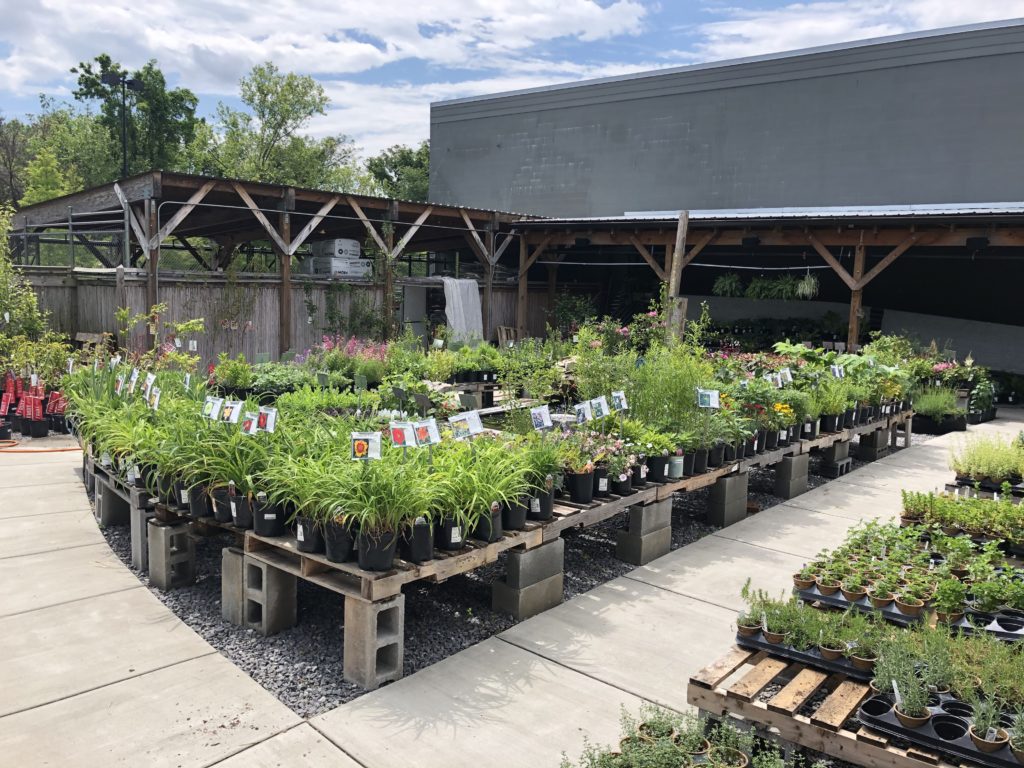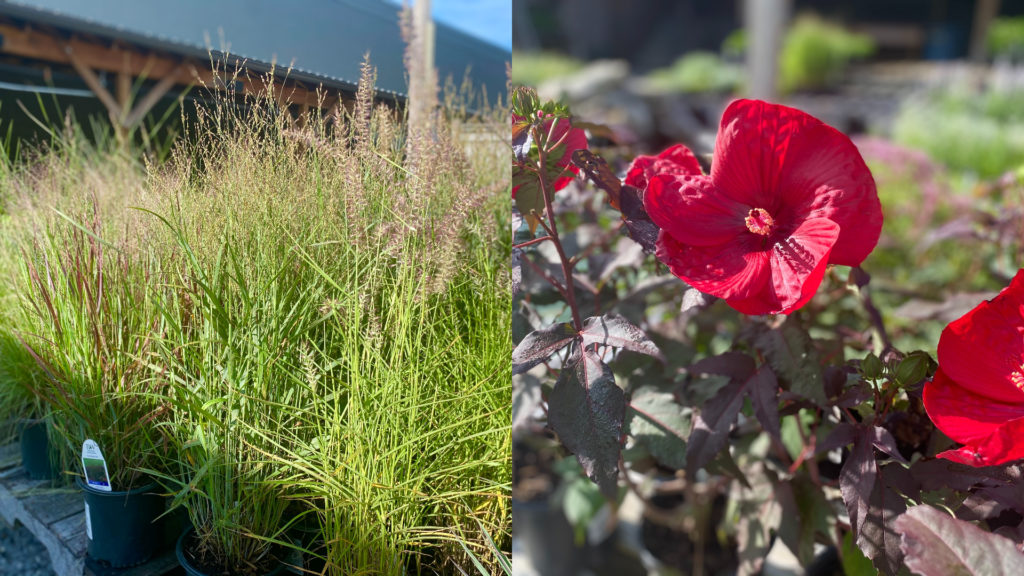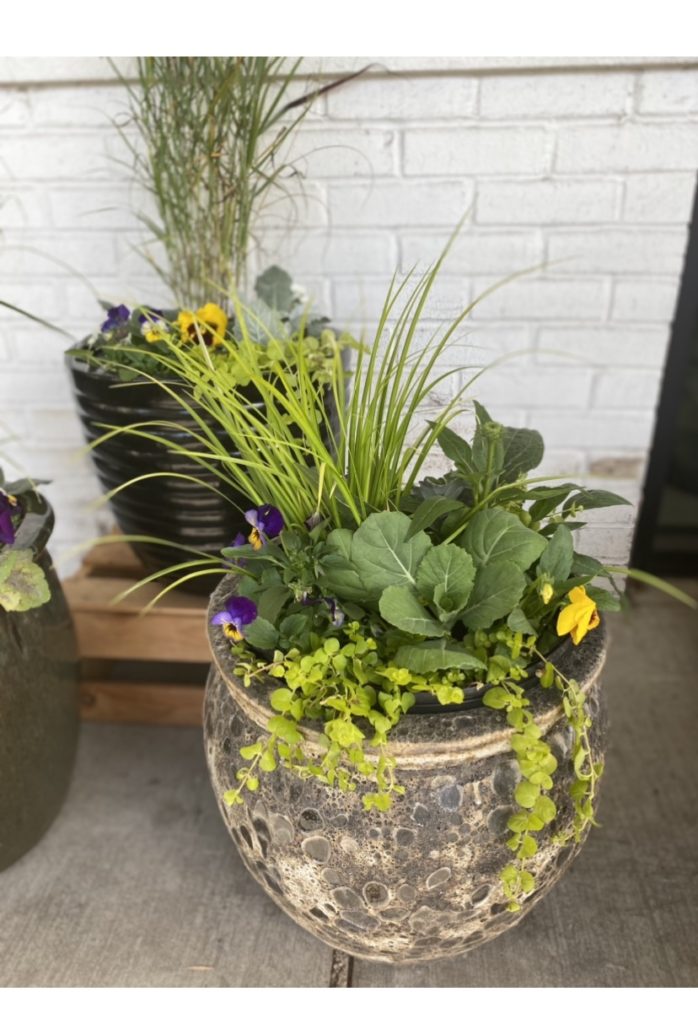Let’s set the stage: You find a great deal on the perfect ceramic pot to go beside your front door. It’s time to do it up, so you peruse Pinterest for inspiration and excitedly take a trip to the local nursery to purchase your plants, but when you get there and begin looking around you become completely overwhelmed, paralyzed. Dang, I’ve been there!

Creating beautiful, balanced, professional-looking containers doesn’t have to be intimidating. Learning a simple design technique was a total game changer for me, making it possible to adapt and choose combinations for various seasons, conditions, and container sizes and make it look good every time. This 3-part formula is both brilliantly simple and easy to remember, delivered in three words for a fun-to-say phrase – Thriller, Spiller, Filler!
I’ll break down each of these components in more detail and discuss how to select and play with them to add to the overall aesthetic and work with your conditions, but there are a few pieces of information you’ll want to gather first. These will need to be considered regardless of which specific Thriller, Spiller, and Filler plants you choose and what color scheme, theme, or aesthetic you’re after.
- Sunlight: How much light will your container get? Is it in full sun, partial shade, or full shade? It is important to choose plants with the same lighting needs. Ferns don’t like full sun and echinacea doesn’t like shade, so these two plants will not fare well together.
- Container Size: The size of your container will determine how many plants and what size plants to choose. A 12” diameter container is typically around 5 gallons by volume. It would be appropriate to select 3 1-gallon and 3 quart size plants for this container but 6 1-gallon plants would be too crammed.
- Season/Zone: Depending on where you live, some plants will work better than others, especially when you’re creating an outdoor container. Therefore, it is important to know which plants are zone hardy, what constitutes an annual versus a perennial, and what plants are best suited for the season you’re in.
Once you have answers to these questions, you’re ready to start thinking about your plant combinations. One of our staff designers explained that her next consideration is color. Perhaps you love purple and want to use shades of purple to accentuate your burgundy trim paint. You can create a more monochromatic, muted palette or go bold with weightier, brighter colors. Of course, the color and texture of your planter should factor into this decision. Generally speaking, dark-colored pots will not work well with deeper-hued plants and vice versa. Warm colors like deep red, oranges and yellow will contribute to a fall-themed container whereas pastels may be better suited for spring. Likewise, containers can be planned with purpose such as to attract pollinators or to provide culinary components such as herbs or greens. All of this should be considered in advance.
Now, onto the actual selection of your THRILLERS, FILLERS, and SPILLERS!
Thriller: Your thriller is your focal point. It is the tallest plant in your design, the main attraction, and is intended to add drama. Some of our favorites include:
- full sun: tall ornamental and fountain grasses; evergreens (sky pencil holly, mini arborvitae); salvia; dahlia; hibiscus; sunflowers; canna lily
- shade/partial shade: alocasia*; ferns; astilbe; digitalis (foxglove); cordyline* * depending on zone hardiness

Filler: The filler is the middle layer of your container. Opt for one or several depending on the size of your container. Fillers provide texture and color and should complement the thriller. They fill the gaps and are often rounded, mounded, and balanced.<
- full sun: bedding plants like pansies, violas, and petunias; cosmos; lantana; achillea; lavender; phlox; zinnia; sun coleus; ornamental cabbage/kale; alyssum; herbs like basil; geranium; lamium; lamb’s ear
- shade/partial shade: heuchera; heucherella; tiarella; begonias/rex begonia; impatiens; ferns, dusty miller, shade coleus

Spiller: Spillers are often designated by having “trailing” in their name. They will hang over the side of the container to hide the lip. Choosing plants with bright colors and variegation will make a statement. Spillers can also “fill” but should have a cascading effect.
- full sun: trailing vinca; calibrachoa; Sweet potato vine; verbena; trailing rosemary; creeping thyme;
- shade/partial shade: Lysimachia (Creeping Jenny); creeping fig; creeping wire vine; asparagus fern; wandering dude; trailing lobelia

After choosing your plants, it’s now time to assemble your combo pot! We could spend much more time discussing soil, planting methods, care, and so on but this post is more focused on design. However, we are big fans of Happy Frog Potting Soil and Coast of Maine Bar Harbor for containers. If you have a deep container, we recommend inserting a Bloem Ups-A-Daisy to elevate the soil. A piece of mesh over the drainage hole will prevent obstruction and a set of Pot Feet or Down Under Plant Caddy bring your container up off the surface to keep it clean and dry.
Here’s a combination we love designed by Amanda at our Asheville location:
 Thriller: Acorus Wogon, Fillers:, Pansy Matrix Lavender, Viola Tiger Yellow, Ornamental Kale & Cabbage, Spiller: Lysimachia (Creeping Jenny)
Thriller: Acorus Wogon, Fillers:, Pansy Matrix Lavender, Viola Tiger Yellow, Ornamental Kale & Cabbage, Spiller: Lysimachia (Creeping Jenny)

Leave a Reply